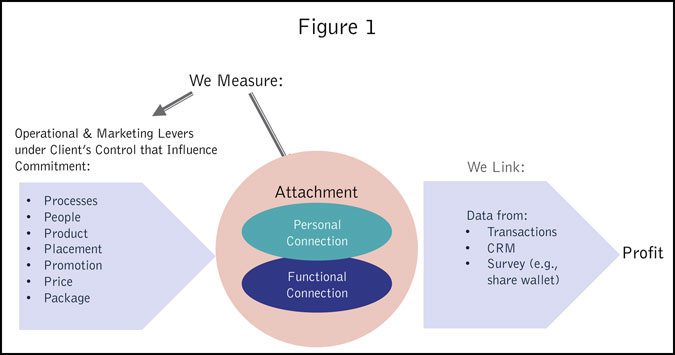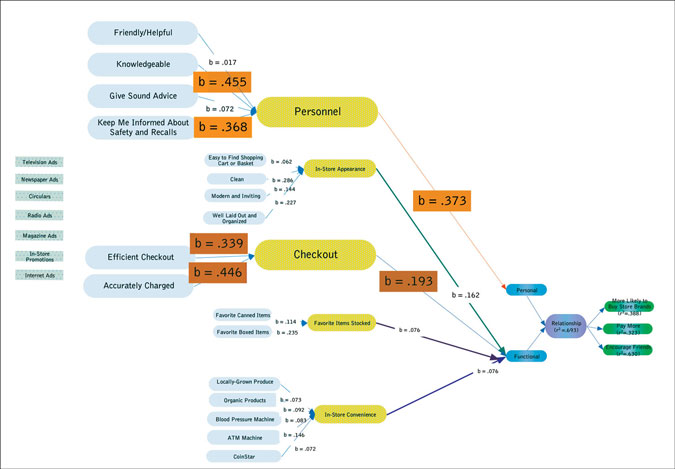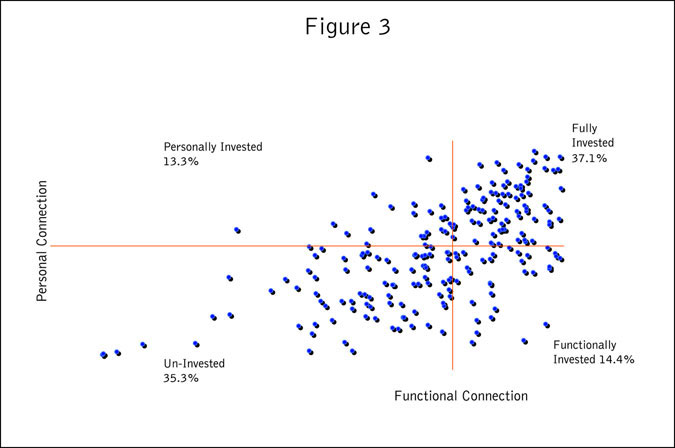Now and for the future
Editor’s note: Kevin Schulman is senior vice president at TRG iSKY, a Laurel, Md., research firm.
For decades, business has pursued the formula for customer loyalty, but the secret to creating enduring customer relationships remains elusive. Over the years, satisfaction, value and quality have all taken their turn as the key to customer profitability, but one by one each has proven to be a poor indicator of future customer behavior. Costly investments designed to attract and retain customers do indeed improve survey scores but often have limited impact on the bottom line.
One example from the automotive sector shows a .35 bivariate correlation between the J.D. Power Customer Service Index and repeat purchase of the same automotive brand. Experience across industries shows correlation ranges between .25 and .4 - which is only a weak to moderate relationship. Measuring satisfaction without measuring customers’ relationships and how they got that way leaves companies chasing scores that most often don’t predict future behavior.
What contributes
There is a large body of academic work dedicated to understanding and explaining what contributes to good and bad interpersonal relationships. To summarize, for a relationship to truly exist, interdependence between partners must be evident: that is, the partners must collectively affect, define and redefine the relationship (Hinde 1979). At their core, relationships are purposive, they add structure and meaning in a person’s life (Hinde 1995).
In the marketing world these basic relationship principles - applied to consumers - have become the accepted framework, replacing short-term exchange conceptions (e.g., transactional and episodic customer interactions) for what is required to maximize profitability. The literature on interpersonal relationships often describes (with varying terms) two broad need states necessary for healthy relationships - functional and personal. The former is utilitarian and cognitive and manifests as a sense of reliability and basic needs being met (e.g., satisfaction). The latter is less tangible, less rational and manifests as trust and affective feelings.
In short, a healthy relationship requires functional and personal benefits that manifest as a sense of reliability, satisfaction, trust and commitment. For a business to strengthen customer relationships it must have a measurement system to evaluate these dimensions and an understanding of the specific relational activities required to support them.
The relationship investment model was developed - as the name suggests - using the theoretical framework of relationship theory. It is a system to measure the psychological constructs in relationship-building (e.g., trust, reliability, satisfaction, commitment) and identify the specific business activities required to strengthen customer relationships. At its core is a concept we call customer attachment that captures the motive or intent behind loyal behavior (e.g., repeat purchase, share of wallet, referral). What is measured is an attitudinal outcome - not transient attitudes and not behaviors - that is global, stable and predictive.
The attachment construct includes two types of customer connections: functional and personal (Figure 1). Attached customers have functional connections with the brand based on fulfilling their practical needs and personal connections that indicate reciprocal loyalty and emotional investment. Attached customers spend more, visit more often and overcome obstacles to purchasing the brand.
The real value however is in knowing the specific relationship between attachment and key financial metrics (i.e., the output side) and what drives customer attachment (i.e., the input side). This is conceptually reflected in Figure 1, with attachment as the intermediary through which we identify operational and marketing levers, under the client’s control, that influence customer attachment and correspondingly drive loyal customer behavior (e.g., spend). The survey development process for the diagnostics (left side) follows a modified four Ps framework that is useful for thinking through all the possible drivers of attachment.
The model allows for scenario planning and ROI forecasting since possible investments on the left (i.e., increased spend to make improvements) can be linked to unique dimensions of customer attachment, and through these, connected to financial metrics and profitability forecasts.
Piloted a study
TRG iSKY, using a convenience sample, piloted a study measuring the attachment levels of customers to their most frequently shopped grocery store. We also developed a wide-ranging set of diagnostics as possible predictors of customer attachment in the grocery store vertical. Using the six Ps framework the survey was designed to include items such as:
Sample people questions
• Grocery X has knowledgeable employees
• Grocery X has friendly employees
Sample product questions
• Variety, freshness and availability ratings for deli, bakery, meats
Sample process questions
• Grocery X stores are well laid-out and organized
• In-store specials are clearly marked
• At Grocery X I get checked out quickly and efficiently
Each respondent was also asked the proprietary list of six customer attachment questions. And because we did not have access to actual scanner or CRM data we collected self-reported attitudinal loyalty measures as a proxy (e.g., likelihood to recommend, willingness to pay more) for financial outcome measures.
The overall model, reflected in Figure 2, is actually a combination of multiple models that show direct and indirect paths (not all reflected here) of influence and relationship. The beta scores (b) are analogous to driver analysis, with larger scores indicating greater influence on the intermediate (e.g., conceptual drivers, customer attachment) and outcome variables.
More specifically, the graphic shows the connection between relationship investment (in purple) to grocery stores and key behavioral outcomes. It also shows, at a factor (yellow) and diagnostic (light blue) level, the drivers of relationship investment and its subdomains, personal and functional connections (dark blue). While not fully reflected in this graphic, the model from this data set can show how specific promotional channels (far left) influence the specific diagnostic levers.
It should be noted that the data and relationships reflected in this graphical (and static) version of the model can be used to build a more user-friendly interface and interactive tool for managers to a) quickly process the main findings and b) do what-if scenario planning by changing the inputs on the left (i.e., customer ratings) to get a predicted change in relationship investment levels and key behaviors on the right (output side).
Biggest drivers
The beta scores (b) from the model indicate the biggest drivers of relationship investment. In the personnel grouping (and for the entire model) the biggest driver of creating customer attachment is knowledgeable staff who give good, in-store advice on what to buy (beta of .455). This attribute is distinctly different from friendly or helpful staff and it does represent an operational and human resources opportunity to help drive strong, attached customer relationships and increase key behavioral outcomes (e.g., store-brand purchase, recommend, spend). However, it also represents significant investment costs in the form of training, incentives, wages and ongoing support.
As an example, by investing heavily in its knowledge-management portal, Giant Eagle, a U.S. grocery retailer, is looking at improved financial competitiveness, efficiency of operation and increased market share. The management at Giant Eagle is hoping that by leveraging its digital-sharing system to promote the sharing of important ideas, best business practices and lessons learned, the entire organization will become transformed by a new culture of knowledge sharing.
The other major driver in the personnel grouping is “keeping customers informed of safety issues and recalls” - a negative situation that occurs infrequently. Why does this, among all the possible predictors of relationship-building, matter so much and how can it be operationalized in any meaningful way? The answer to the first part of this question is a realization of the importance of trust as a latent part of the personal connection dynamic. Trust, another well-studied concept in academia, is required because of imperfect information on the part of the consumer. At some level, the consumer is required to take a leap of faith with every transaction - an action made possible through the establishment and fostering of trust.
Ultimate demonstration of trust
An infrequent but crisis-driven event such as a product recall is, perhaps, the ultimate demonstration of trust. The retailer must be, above all else, transparent and forthright, providing all the information it has to the consumer. Beyond mitigating the damage of the specific event, doing this right can foster long-lasting trust with many reciprocal benefits, including strong personal connections. As one possible action step, retailers should review their crisis/recall action plan, including consumer communications, to make sure it meets the transparent and forthright criteria.
Price Chopper, Schenectady, N.Y., and Wegmans, Rochester, N.Y., are two grocery store chains using this type of information system to help send out recall alerts. When shipments of beef were recalled because of a possible threat of E. coli bacteria contamination, Wegmans used a voice relay company called SmartReply to quickly alert over 190,000 customers about the recalled meat. Similarly, Price Chopper used SmartReply to alert customers who purchased Samuel Adams beer that the product was being recalled because of possibly defective bottles. Over 12,000 Price Chopper AdvantEdge loyalty card members received a call alerting them to the possible defect. “We are able to isolate the folks that need to know when it comes to food safety and security. We feel an obligation to help customers know the information they need to know and the response on the part of customers has been quite grateful,” Price Chopper spokeswoman Mona Golub told the Daily Gazette of Schenectady, N.Y.
Another important operational driver of customer attachment is the efficiency and accuracy of the checkout process. This is a regular opportunity to make operational improvements that will impact satisfaction with a given shopping experience but also increase customer attachment and profitability. As one recent example makes clear however, operational efficiencies and productivity gains at checkout may have unintended consequences on the long-term financial value derived from strong customer relationships.
Walker, Mich.-based retailer Meijer began a program - first developed for manufacturing assembly lines - of breaking down the checkout process into discrete segments to be timed, measured and benchmarked. All employees must meet key time benchmarks or face termination. The approach is rooted in the theories of Frederick Taylor from the early 20th century, which were used to break down tasks into units to determine the maximum work a person could do. The efficiency gains are all but guaranteed with such a system but at what cost?
As reported by The Wall Street Journal (“Stores Count Seconds to Trim Labor Costs” November 13, 2008) reactions from customers of some Michigan Meijer stores vary. “Sometimes you like to get in and get out right away,” said Barb Bush, who shops at stores in DeWitt and Owosso and said she likes the current system. “A lot of [the cashiers] like to stop and chat, and I don’t really have the time for it.”
Linda Long, who shops at the Okemos store weekly, said of the cashiers: “Everybody is under stress. They are not as friendly. I know elderly people have a hard time making change because you lose your ability to feel. They’re so rushed at checkout that they don’t want to come here.”
Success or outcome measures for such an initiative should include assessing the impact on customers’ personal and functional connections to the brand. Productivity gains could be greatly offset by weakened customer relationships, which could have not only a long-term but immediate impact on revenue. However, to have any credence as a financial argument, the linkage between customer relationships - a “soft” and abstract concept as opposed to worker productivity, which can be measured by time and output - and financial metrics must exist.
The food
What may be as or even more interesting is what is relatively less important: the food. Product quality and its specific dimensions (e.g., freshness, availability, variety) are likely to be considered table-stakes attributes - the entry price to be in the grocery business. While product quality is quite likely to have an impact on customer satisfaction with a given experience it is a likely to be a binary dimension - e.g., presence or absence of it - and perhaps not even the primary satisfaction driver.
This may be less true for destination categories (e.g., meat, bakery) but in the aggregate, product quality is difficult to differentiate - certainly within a given retail format - and likely becomes, at least partially, subsumed in importance by all the other process-based elements of a shopping experience (e.g., driving to store, parking, shopping, checking out). This explains its failure to show up as a major contributor to building customer relationships beyond the utilitarian variety that meets basic needs. We find that service quality is by far the most critical determinant of merchandise quality perception
Store brands can help drive loyalty
Is it possible for a store brand to have premium brand characteristics and for shoppers to exhibit a preference for them based on non-price attributes? There is plenty of anecdotal evidence and academic research to support the notion that store brands can help drive store loyalty. Our studies lend support to the store brand strategy and find retailer/store-level attachment is transferable to the store-branded product level. As evidence, those with a fully-attached relationship to their most-frequented grocery store are three times more likely to buy store brands - this is an expected outcome from increasing store-level customer attachment. And because the strategy focuses on a psychological state in the customer - increasing the emotional and functional connection and corresponding motivation to maintain it - there is the potential to permanently increase store brand share.
Our research supports the belief that customers with a fully attached relationship to their retailer give greater share-of-wallet, make more trips, are more willing to recommend and have bought and will buy more store-brand items. For example, 36 percent of customers with strong relationships with their most-frequented grocery store give 75 percent to 100 percent share-of-wallet, twice the percentage who do so among those with a weak relationship (only 18 percent give 75 to 100 percent share-of-wallet).
Natural customer typology
The relationship investment model framework of personal and functional connections is designed to create a natural customer typology. It is not a linear continuum but rather four discrete groups or customer segments, including functionally invested, personally invested, fully invested and the un-invested.
In the grocery retail space the study found 37 percent of customers across all retailers with a fully-invested relationship, only slightly more than the percentage with no real connection to their retailer. The personally-invested, representing 13 percent of all customers, have some personal, more emotive connection to the retailer but lack the basics from the relationship. This customer is probably not scoring stores well on customer satisfaction surveys and generally is less than fully satisfied with the individual shopping experiences.
However, this customer may be markedly different from the dissatisfied ones identified in a customer satisfaction context. The retailer did manage to engender some level of connection - there is a relationship to build. In this study those with only a personal relationship were far more likely to have had a problem that was resolved by customer service, which underscores the opportunity that can often arise from less-than-positive circumstances when relational instead of transactional exchange theories are used as the filter for analyzing customer relationships.
The map shown in Figure 3 can be produced at a customer level for a store’s customers or competitors. It can be also be produced at the store level to identify the top- and bottom-tier store performers based on strength of customer relationships and begin determining how the best performers currently deliver on the key drivers of customer attachment and relationship investment.
Increase the strength
Macroeconomic trends are redefining customer mindset and shopping behaviors. The operating environment is extremely difficult and the tendency will be to retrench, slash costs, maximize productivity and wait for better times. Those retailers and CPG firms that temper this tendency with a determination to not only preserve but increase the strength of customer relationships will likely be the winners. Relationship theory offers a framework for understanding how to measure and manage these relationships. The underlying construct of attachment - the motive or intent to sustain a relationship - is a key mediating concept between what the firm does (the inputs) and how it affects customer behavior (the outputs).
Specific models, such as the relationship investment model, can be built to understand the impact of specific operational and marketing activities on customer attachment and behavior (e.g., share-of-wallet). The construct of customer attachment can then be tracked at various touchpoints to evaluate the impact on customer relationship strength of daily operations (e.g., at checkout) and marketing programs (e.g., promotions). With this information, a business can guide its decision-making with knowledge of what the customer will do next - the future behavior that is necessary to support tomorrow’s sales and pave the way for even greater success when better economic conditions are upon us.
